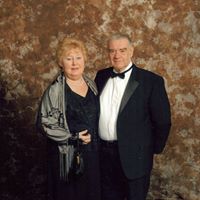Brian F Hume
age ~53
from Sedalia, MO
- Also known as:
-
- Bryan Hume
Brian Hume Phones & Addresses
- Sedalia, MO
- 5114 Thornwood Dr, Westerville, OH 43082
- 713 Erin St, Lewis Center, OH 43035 • 6148465558
- Maineville, OH
- 12360 Richmond Ave, Houston, TX 77082 • 2818709887
Resumes

Brian Hume
view source
Brian Hume
view sourceName / Title
Company / Classification
Phones & Addresses
Director, President
Monroe, Ltd
Us Patents
-
Heat Engine And Heat To Electricity Systems And Methods
view source -
US Patent:20100156112, Jun 24, 2010
-
Filed:Dec 4, 2009
-
Appl. No.:12/631379
-
Inventors:Timothy J. Held - Akron OH, US
Stephen Hostler - Akron OH, US
Jason D. Miller - Hudson OH, US
Brian F. Hume - Westerville OH, US -
International Classification:H02K 7/18
F01K 27/00
F04B 17/03 -
US Classification:290 1 A, 60643, 417405
-
Abstract:A waste heat recovery system, method and device executes a thermodynamic cycle using a working fluid in a working fluid circuit which has a high pressure side and a low pressure side. Components of the system in the working fluid circuit include a waste heat exchanger in thermal communication with a waste heat source also connected to the working fluid circuit, whereby thermal energy is transferred from the waste heat source to the working fluid in the working fluid circuit, an expander located between the high pressure side and the low pressure side of the working fluid circuit, the expander operative to convert a pressure/enthalpy drop in the working fluid to mechanical energy, a recuperator in the working fluid circuit operative to transfer thermal energy between the high pressure side and the low pressure side of the working fluid circuit, a cooler in thermal communication with the low pressure side of the working fluid circuit operative to control temperature of the working fluid in the low side of the working fluid circuit, a pump in the working fluid circuit and connected to the low pressure side and to the high pressure side of the working fluid circuit and operative to move the working fluid through the working fluid circuit, and a mass management system connected to the working fluid circuit, the mass management system, method and device having a working fluid vessel connected to the low pressure side of the working fluid circuit and configured to passively control an amount of working fluid mass in the working fluid circuit.
-
Thermal Energy Conversion Method
view source -
US Patent:20110061387, Mar 17, 2011
-
Filed:Dec 4, 2009
-
Appl. No.:12/631400
-
Inventors:Timothy J. Held - Akron OH, US
Stephen Hostler - Akron OH, US
Jason D. Miller - Hudson OH, US
Brian F. Hume - Westerville OH, US -
International Classification:F01K 25/08
F01K 13/00
F01K 19/00 -
US Classification:60651, 60671, 60653, 60692, 60693
-
Abstract:A waste heat recovery system, method and device executes a thermodynamic cycle using a working fluid in a working fluid circuit which has a high pressure side and a low pressure side. Components of the system in the working fluid circuit include a waste heat exchanger in thermal communication with a waste heat source also connected to the working fluid circuit, whereby thermal energy is transferred from the waste heat source to the working fluid in the working fluid circuit, an expander located between the high pressure side and the low pressure side of the working fluid circuit, the expander operative to convert a pressure/enthalpy drop in the working fluid to mechanical energy, a recuperator in the working fluid circuit operative to transfer thermal energy between the high pressure side and the low pressure side of the working fluid circuit, a cooler in thermal communication with the low pressure side of the working fluid circuit operative to control temperature of the working fluid in the low side of the working fluid circuit, a pump in the working fluid circuit and connected to the low pressure side and to the high pressure side of the working fluid circuit and operative to move the working fluid through the working fluid circuit, and a mass management system connected to the working fluid circuit, the mass management system, method and device having a working fluid vessel connected to the low pressure side of the working fluid circuit and configured to passively control an amount of working fluid mass in the working fluid circuit.
-
Thermal Energy Conversion Device
view source -
US Patent:20110185729, Aug 4, 2011
-
Filed:Dec 4, 2009
-
Appl. No.:12/631412
-
Inventors:Timothy J. Held - Akron OH, US
Stephen Hostler - Akron OH, US
Jason D. Miller - Hudson OH, US
Brian F. Hume - Westerville OH, US -
International Classification:F01K 27/00
-
US Classification:60643
-
Abstract:A waste heat recovery system, method and device executes a thermodynamic cycle using a working fluid in a working fluid circuit which has a high pressure side and a low pressure side. Components of the system in the working fluid circuit include a waste heat exchanger in thermal communication with a waste heat source also connected to the working fluid circuit, whereby thermal energy is transferred from the waste heat source to the working fluid in the working fluid circuit, an expander located between the high pressure side and the low pressure side of the working fluid circuit, the expander operative to convert a pressure/enthalpy drop in the working fluid to mechanical energy, a recuperator in the working fluid circuit operative to transfer thermal energy between the high pressure side and the low pressure side of the working fluid circuit, a cooler in thermal communication with the low pressure side of the working fluid circuit operative to control temperature of the working fluid in the low side of the working fluid circuit, a pump in the working fluid circuit and connected to the low pressure side and to the high pressure side of the working fluid circuit and operative to move the working fluid through the working fluid circuit, and a mass management system connected to the working fluid circuit, the mass management system, method and device having a working fluid vessel connected to the low pressure side of the working fluid circuit and configured to passively control an amount of working fluid mass in the working fluid circuit.
-
Thermal Energy Conversion Method
view source -
US Patent:20140345279, Nov 27, 2014
-
Filed:Aug 4, 2014
-
Appl. No.:14/450410
-
Inventors:Timothy James Held - Akron OH, US
Stephen Hostler - Akron OH, US
Jason D. Miller - Hudson OH, US
Brian F. Hume - Westerville OH, US -
Assignee:ECHOGEN POWER SYSTEMS, LLC - Akron OH
-
International Classification:F01K 7/16
F01K 3/18
F01K 25/10 -
US Classification:60645, 60327
-
Abstract:A method for converting thermal energy into mechanical energy in a thermodynamic cycle includes placing a thermal energy source in thermal communication with a heat exchanger arranged in a working fluid circuit containing a working fluid (e.g., sc-CO2) and having a high pressure side and a low pressure side. The method also includes regulating an amount of working fluid within the working fluid circuit via a mass management system having a working fluid vessel, pumping the working fluid through the working fluid circuit, and expanding the working fluid to generate mechanical energy. The method further includes directing the working fluid away from the expander through the working fluid circuit, controlling a flow of the working fluid in a supercritical state from the high pressure side to the working fluid vessel, and controlling a flow of the working fluid from the working fluid vessel to the low pressure side.
License Records
Brian A Hume
License #:
8227 - Active
Category:
Electricians
Issued Date:
Sep 8, 1988
Expiration Date:
Oct 31, 2019
Type:
Electrician Master
Brian A Hume
License #:
7720 - Expired
Category:
Electricians
Issued Date:
Feb 2, 1988
Expiration Date:
Oct 31, 1994
Type:
Electrician Journeyman
Googleplus

Brian Hume
Education:
University of British Columbia

Brian Hume
Work:
Hebron Baptist Church - Director of Media

Brian Hume

Brian Hume

Brian Hume

Brian Hume

Brian Hume

Brian Hume
Tagline:
Boludeces no!
Plaxo

Brian Hume
view sourceYoutube
Classmates

Brian Hume
view sourceSchools:
Bennett Elementary School Manassas VA 1980-1985, Marsteller Middle School Manassas VA 1985-1988
Community:
Gina Ross, Bill Adler, Jane Stokely, Andre Alexander

Brian Hume
view sourceSchools:
Banff High School Banff Azores 1958-1962
Community:
Shirley Smith, Pat Masterson, Jacquie Strong, Debbie Kernick

Brian Hume
view sourceSchools:
Oxford Ave. School Ventnor City NJ 1970-1972, Ventnor Educational Community Complex Ventnor City NJ 1975-1977

brian hume, Dartmouth Hig...
view source
Brian Hume, Oakcrest High...
view source
Ventnor Educational Commu...
view sourceGraduates:
Brian Hume (1975-1977),
Pamela Rasansky (1987-1993),
Eve Rose (1957-1960),
Wendy Deal (1965-1975),
Daniel Newhart (1989-1991),
Elaine Licata (1963-1966)
Pamela Rasansky (1987-1993),
Eve Rose (1957-1960),
Wendy Deal (1965-1975),
Daniel Newhart (1989-1991),
Elaine Licata (1963-1966)

Banff High School, Banff,...
view sourceGraduates:
Brian Hume (1958-1962),
Bev Worrell (1960-1964),
Justin Todd (1997-2001),
Bob Gilmore (1977-1979),
Nadia Mazzuca (1991-1995)
Bev Worrell (1960-1964),
Justin Todd (1997-2001),
Bob Gilmore (1977-1979),
Nadia Mazzuca (1991-1995)

Dartmouth High School, Da...
view sourceGraduates:
brian hume (1965-1969),
margaret yarn (1974-1978),
Mike Brown (1962-1966),
Mike Elliott (1962-1966),
Raegan Lewis (1988-1992),
Heather Allan (1973-1977)
margaret yarn (1974-1978),
Mike Brown (1962-1966),
Mike Elliott (1962-1966),
Raegan Lewis (1988-1992),
Heather Allan (1973-1977)

Brian Hume
view source
Brian Hume
view source
Brian Hume
view source
Brian Hume
view source
Brian Hume
view source
Brian Hume
view source
Brian Hume
view source
Brian Hume
view sourceFlickr
Myspace
Get Report for Brian F Hume from Sedalia, MO, age ~53

















